|

| In the fall of 2007 and 2009,
Michael's medical students at Kunming Medical University created the
following descriptions of portions of a mural in Kunming. (They were free
to describe it as they wished; each group also
did an oral presentation.) By reading these
academic paragraphs, I hope you learn some things about the history
and practice
of medicine in China. (If you find mistakes with the "facts" on this
page, please let me know. Thanks.)
Click here for page two |
|
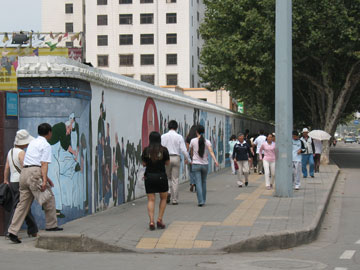 |
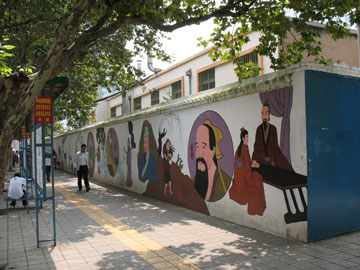
|
|
Kunming’s Chinese Medical
History Wall
Dozens of medical images
have been painted on the wall outside Kunming’s biggest hospital,
illustrating how both Chinese and western medicine have played important
roles in disease prevention and health promotion in China. In order to
welcome the national Special Olympics for disabled athletes (May 2007),
Wang Feng created the mural with ideas from his imagination and
suggestions from the First Affiliated Hospital of Kunming Medical
University. He drew the mural by hand. The first part of the mural is
about the past, when Chinese medical science was the only way to prevent
disease and improve people’s health. It features several famous doctors,
such as Hua Tuo and Li Shizhen. The second part shows how modern medical
practices are used in China today to help Chinese doctors diagnose and
treat disease. The wall even shows how foreign doctors have come and
helped China develop advanced medical techniques. Wang Feng’s mural
outside Kunming’s First Affiliated Hospital is a graphic illustration of
the cooperation between traditional Chinese medical science and modern
western medicine that have brought a better quality of life and longer
life expectancy to Chinese people.
Group A09: Annie, Cameron,
Miao Hui, Alice, Kitty
When you go by the first affiliated hospital of Kunming Medical
University, you may be attracted by the beautiful mural on the wall. The
mural was created to welcome the national Special Olympics for disabled
athletes, which was held in May, 2007. The artist, Wang Feng, is a student
at Yunnan Art College. The mural originated from suggestions from the
hospital and also from the artist's imagination. He drew the mural in
three parts. Firstly, it depicts the development of medicine from ancient
to modern times. Secondly, it shows the great effect foreign western
medicine has had on our country's medical science. For example, a famous
foreign surgeon, Dr. Bethune, made a great contribution to our country's
people and medicine. Thirdly, it shows aspects of the first affiliated
hospital of Kunming Medical University, especially in respect to changes
in equipment and service attitudes in recent years. Wang Feng said he drew
the mural by hand with the help of computer. As a way to welcome disabled
athletes to Kunming, and to teach pedestrians about the history and
development of medical science, this beautiful mural is a great addition
to our community.
Team A07: Emily, Apple, Zuo Zan, Zhang Min |
|
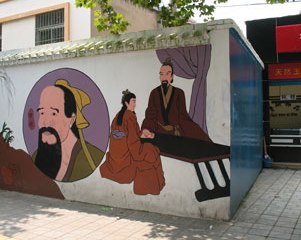
Huatuo--Ancient Chinese
Medical Scientist
Huatuo was a famous ancient
Chinese medical scientist, best remembered for his creative discoverys and
high sense of morality. During the late Han dynasty (202 B.C.~A.D. 220),
Huatuo created Ma-fei-san (麻沸散),
which was the ancestor of modern anesthesia. He is also considered to be
the first surgeon in China, because he was the first doctor who cut people
open to save lives. Furthermore, Huatuo was also known for inventing Wu-qin-xi
(五禽戏),
in which one imitates the actions of tigers, deer, bears, apes and birds.
Doing this improves people’s immune systems, which in turn helps to
prevent illness. In addition to his innovative medical skills, Huatuo’s
medical morality has been respected for generations. He always treated
poor people without receiving a single coin and he also was a person who
indulged himself into medical scientific study with no expectation for
fame. China’s ancient physician Huatuo possessed the spirit of morality
and creativity, and through new practices like anesthesia and surgery he
saved many lives and set an example for doctors throughout the ages.
Group B09: Lilly, Nancy,
Yeting, Hebin, Sally
Hua
Tuo (AD 110-207) was a famous physician in Ancient China, sometimes called
the “divine physician”. As the first famous Chinese surgeon, he developed
the use of anesthesia, and furthered the limited Chinese knowledge of
anatomy. Hua Tuo, a master in internal medicine, surgery and acupuncture,
succeeded in saving the lives of numerous patients. He was an extremely
honorable person, remembered for his contribution to the later advancement
of Traditional Chinese Medicine. Although Hua Tuo passed away thousands of
years ago, his admirable medical skills and his humanitarian spirit will
be remembered forever; that is why his image is a fitting way to begin
this mural.
Team B07: Xu Pei, Kimi, Tan Si, Zhu Long |
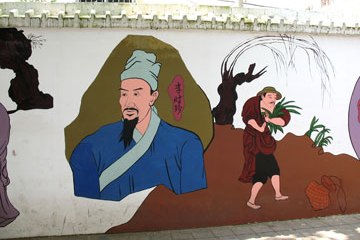
Li Shizhen --A Famous
Pharmacologist
Li Shizhen (1518-1593) was
a famous medical author and pharmacologist in ancient China, and he
remains a role model for medical students today. He was born in an old and
well-known medical family in the Ming dynasty. For 10 years, he read
widely and practiced diligently. Through hard work, he became a famous
doctor. Meanwhile, he noticed many mistakes in previous medical books, so
he made up his mind to correct those false theories. During 27 years, by
practicing medicine in many mountain villages and trying various
experiments, he made innumerable observations and collected a large number
of different plants, minerals and animals, and finally finished his
pharmacology masterpiece
《本草纲目》(Ben
Cao Gang Mu). Later on, it was his critical thinking skills, creativity
and strong will power that encouraged doctors to dedicate themselves to
medical science. Li Shizhen is regarded as the most influential
pharmacologist in ancient China; his book《本草纲目》(Ben
Cao Gang Mu) and his arduous experiences have inspired doctors to be
objective and analytical, and are great treasures in the field of
medicine.
Group C09: George, Carol,
Sue, Lydia, Bruce
Li
Shizhen, one of the greatest scientists in China's history, was considered
a medical saint. Long ago, some people said they had magical power to
treat patients. These wizards and witch-doctors used some odd ways to
treat the sick. With the development of society, people began to find ways
to protect themselves. Li Shizhen (1518-1593) was born in the Ming
Dynasty. He traveled over numerous mountains and rivers to collect a large
number of folk prescriptions. It took him 27 years to finish his great
work, the Compendium of Material Medica (本草纲目), which was monumental in
China's pharmaceutical history. Li Shizhen, a pioneer in Chinese medicine,
gathered medicinal herbs and treated ill people, them people began to know
what caused illnesses and how to treat them.
Team C07: Moon, Grace, Helen, Dylan |
|
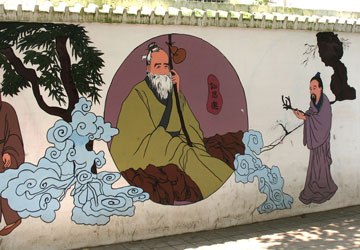
Sun Simiao--The King of Medicine
Sun Simiao (541 A.D.-682 A.D.) was a
famous traditional Chinese medicine
doctor
who is known as the father of
prescription science because he wrote
《千金方》(Qian
Jin Fang) after studying the basic components of medicine.
Sun is
also called
“Yao Wang” (the king of medicine) in
China. His biggest contribution was to develop the method of using
medicine. His research is reported in many books (he wrote almost 80
books), but 《千金方》(Qian
Jin Fang) is his most remarkable
work. The work contains about 8000 prescriptions to tell other physicians
how to use herbs for medicinal purposes. It also teaches about how to have
a healthy life style,
because bad behaviour can not only lead to illness, but is also a main
reason for recurrence (复发).
Sun worked to develop medicine from the parts of plants and animals. From
gathering herbs to
curing people, Sun did everything on his own. Full of ethical compassion,
Sun believed that people’s lives are more important than gold. Sun Simiao
was a great Chinese medicine doctor whose herb research and influential
book 《千金方》(Qian
Jin Fang) helped prescription science become more
professional and systematic.
Team
D09: Contrina, Wen Xia, Li Yunchao, Liu Xia, Li Jiong, Mary
Sun
Simiao, who lived in the Tang dynasty (581-682 AD), was the "'King of
Chinese Medicine". He was a pharmacist, nutritionist, medicine specialist
and acupuncture specialist. When he was a child, he saw that the poor
around him didn't have money to see a doctor, and most of them died
without treatment. Because of this, he decided to study medicine when he
was 18. During his 102-year life, Sun Simiao devoted himself to his
remarkable medical practice and wrote a 30-volume encyclopedia (Qian Jin
Yao Fang) on Chinese medicine that still exerts influence today. In
addition, Sun Simiao was the first person in the world to initiate
catheterization, and was the first one who cured beriberi, 1000 years
earlier than in Europe. Doctor Sun Simiao will long be remembered for his
pioneering medical work, kind heart for the people, and the important
medical books he left to guide future generations.
Team D07: Angela, Michelle, Chun Lan, Ting Biao |
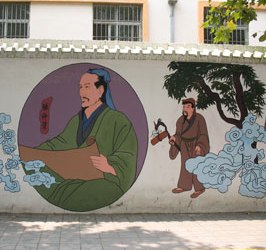
Zhang Zhongjing—Ancient
Chinese Medical Scientist
As a great herbal doctor in
ancient China, Zhang Zhongjing not only created new prescriptions to cure
and save people, but also wrote medical books and invented useful
techniques to enhance medical development. To help the poor people fight
the common cold, Zhang created a prescription (actually a kind of
dumplings) that is made of cotton, pepper and herbal medication. In order
to honor Zhang and his contribution to prescription science, people still
eat dumplings on Winter Solstice Day (冬至).
Zhang also wrote the book
《伤寒杂病论》
(Shang Han Za Bing Lun; Typhoid Fever and Miscellaneous Diseases),
which was quite influential to medical development. The medical knowledge
in his book was the most advanced at that time. In addition, Zhang is the
founder of artificial respiration. He used this technique to save many
lives, and it is still being used today. People, especially young doctors,
should learn from Zhang, because his prescriptions rescued patients from
diseases, his writings deeply influenced medicine, and his discoveries
have saved many lives.
Group E09: Bella, Monica,
Cherry, Zhang Fang, Guo Yue, Gary
Zhang Zhongjing (AD 150-219) is one of the most renowned ancient herbal
doctors in China's medical history. In his lifetime, there were lots of
wars in China and he saw many normal people die with diseases, so he
decided to be a good doctor for them. He went to study Chinese medicine
from his relative, the famous doctor Zhang Bozu. Zhang Bozu thought his
student was very hard-working, therefore he taught him all the knowledge
he knew. When Zhang Zhongjing was 50 years old, there was a grave plague
in China; two thirds of the population were infected. Zhongjing worked
whole heartedly to do research and find solutions to the problem. After
several decades, he finished the book "Shang Han Za Bing Lun". The work
contains over 1 00 effective formulas, many of which are still used today.
The text presented some basic theories of Chinese medicine and implied a
theoretical framework that lead to hundreds of books analyzing, explaining
and reforming it. Zhang Zhongjing is remembered as a model medical
student, and his book presenting both medical formulas and theories is
indeed a cornerstone in Chinese medical history.
Team E07: Maggie, Linda, Persephone, Sophia, Ethan |
|
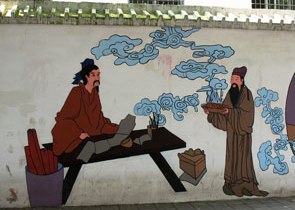
History of Traditional
Chinese Medicine in America
Although Traditional
Chinese Medicine (TCM) has long been accepted as scientific in China, in
America TCM has struggled for its legal status for ages. In the middle of
the 1800s, Chinese herbs first emerged in America, brought by Chinese
laborers. When TCM first appeared in America, Americans regarded Chinese
acupuncture needles and herb teas as an equivalent to necromancy (巫术).
With increased use, more and more Americans came to accept this “magic
medicine”, even though the medical community, government, and mainstream
culture were slow to acknowledge it as medical science. Not until 1994 did
the American Congress authorize the use of Chinese herbs as health
products. In 1997 acupuncture was officially acknowledged as an “efficient
and standard treatment”, and in 2000 TCM was listed as one of the
complementary forms of medicine in the American medicine system. Although
Traditional Chinese Medicine was originally misunderstood and rejected in
America, it has gradually gained acceptance and respect at official
levels, and today it is often considered as an alternative choice when
Americans get sick.
Group F09: Rebecca, Baylee,
Juliet, Sharry
Zhang Zhongjing, (AD
150-219) was a famous medical scientist in Nanyang during the Eastern Han
Dynasty. He enjoys a high reputation at home and abroad in the medical
profession. He has been called "Medical Sage" by the Chinese people. Zhang
Zhongjing read a lot of books about traditional Chinese medicine, which
systematically summed up the essence of medicine before the Han dynasty.
According to his own rich experience in medical practice, he wrote the
book "Shang Han Za Bing Lun" (伤寒杂病论:
The Treatments for Typhoid and other Complicated Diseases), which has 16
volumes in total. The book "Pills of Six Drugs including Rehmannia" is
modified from "Jin Kui Shen Qi Wan," which was also written by Zhang
Zhongjing. It includes the formulas for six drugs and has become a
classical treatment for kidney problems. Zhang Zhongjing was really a
great, kind-hearted doctor; his work is very important to Chinese
medicine, and it is still helping many patients.
Team F07: Helen, Zoe,
Seawind, Fisher, Echo |
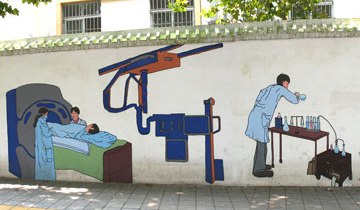
Advanced Auxiliary
Examinations
Advanced auxiliary
examinations are widely used in hospitals to effectively help doctors and
patients, but a reliance on technology also has disadvantages. With the
help of equipment, doctors can diagnose patients with improved accuracy
and cure patients more efficiently. For instance, capsule endoscopy can
find a minimal lesion that can’t even be found during an operation.
Moreover, definite results of advanced tests help verify doctors'
diagnoses and help reduce disputes about medical treatment. However, many
people complain about high medical costs because some doctors ask them to
undergo unnecessary tests in order to improve the utilization of medical
equipment. In addition, false positives are inevitable, which may mislead
diagnosis. Furthermore, medical conditions in China suffer from a serious
imbalance between different regions, as well as between large and small
medical facilities. Doctors in general hospitals find it hard to decrease
reliance on technology, while physicians in small clinics must adapt to
work with less advanced machines. The use of advanced auxiliary
examinations helps improve diagosis and reduce doctor-patient conflicts,
but disadvantages like higher medical costs, misleading results, and
serious "technology" imbalances between China's big and small medical
facilities need to be overcome in order to utilize auxiliary testing
equipment effectively.
Group G09: Echo, Gu Yu,
Sheila, Helen, Feng Jianhua, Jenny
In
the past, doctors used to diagnose according to their clinical experience;
there were many subjective factors and limitations, so the rate of making
diagnostic mistakes was very high. But with the development of science and
technology, various auxiliary diagnostic methods are now available. On the
right of the picture, a technician is doing experiments with a patient's
body fluid, such as a routine blood or urine test. An X-ray machine (shown
in the middle) can be used to do fluoroscopy or radiography of a patient's
chest, head, vertebral column, pelvis and so on. On the left, the patient
is lying on a bedlike machine called a CT (X-ray computed tomography),
used to get sectional pictures inside the patient's body. With modern
tools like these, doctors can get much more objective and correct
information about patients so that they can make an accurate diagnosis.
Team G07: Gao Chang E, Daniel, Chen Min, Tanya, Rose |
|
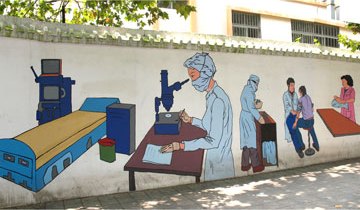
Improvement of Chinese
Diagnostic Technology
In the past three decades,
Chinese diagnostic technology in health care has been improved with the
development of science and technology. Before the past three decades,
diagnosis of diseases mainly relied on experience and physical
examination, for few instruments were utilized to examine the internal
structure of the human body and check for pathology (病理学).
However, the increasing medical use of microscopes helped doctors study
the microstructure of cells, bacteria and viruses. Since the appearance of
microscopes, fewer people have died from infections. Furthermore, doctors
can now use advanced assistant examination equipment, including X-Ray, CT,
and MRI machines, to observe the internal organs and skeleton systems. The
CT/MRI machine has become one of the symbols of a modern hospital, by
means of which doctors can diagnose brain disease, abdominal tumors or
masses, and formulate radiation treatment plans. Nowadays, rapid
pathological diagnosis techniques are widely used in surgery to show the
scope of surgical resection (切除术).
Because of the increasing use of microscopes, X-Ray, CT and MRI technology
over the past 30 years, disease can be diagnosed earlier and more
accurately in China, improving the quality of life for Chinese people.
Group H09: Tang Jianying,
William, Joan, Sun Zhanyong, Candy
These five pictures illustrate the development of medical technology and
science, through which lots of advances in technology have been made to
improve the formerly poor conditions in Chinese hospitals. At the left,
there’s a very useful machine that includes a respirator monitor and a
heart monitor. Secondly, thanks to the microscope, the doctors can test
the blood and bacteria accurately. The middle picture illustrates aseptic
surgical techniques. Since aseptic practices were introduced into the
hospital, they have saved a large number of people who couldn’t have been
cured with drug treatment alone. Next, a doctor is testing blood pressure
with a stethoscope. This examination method is very helpful when looking
for heart and lung illnesses. Finally, a nurse in a pink gown has just
delivered a baby for a pregnant woman. Today, a great number of people
choose to give birth in big hospitals. Thanks to advanced medical
technology, Chinese physicians have made great progress in controlling
illnesses.
Team H07: Dexter, Sam, Erik, Wang Chao Gang |
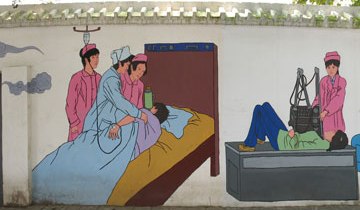
Transition of Nurses' Roles
and Responsibilities in China
The roles and obligations
of nurses in China have transformed through three remarkable stages during
the past three thousands years. From 1500 BC to the early 1900s, doctors
performed the duties now performed by nurses. In fact, the nursing
profession did not exist in China at that time. Doctors gave physical
treatment such as acupuncture (针刺法)
and moxibustion (艾灸术)
and prescribed herbs. Medical care in this stage was called TCM
(Traditional Chinese Medicine). The second stage started at the beginning
of the 20th century, when nurses started taking part in medical treatment.
However, they just followed doctors' orders, confining themselves to
giving injections and transfusions, and paid little attention to patients’
psychological needs. In 2006, the China International Nursing Conference
ushered in a new start in the field of nursing in China. The Conference
determined that nurses ought to have full participation in medical
treatment, including giving drugs, listening attentively to patients and
helping doctors formulate treatment programs. These are shown in the
picture. In the last three thousands years, nursing roles and obligations
have changed in China, first performed by doctors, then (in modern times)
expanding from just giving medications to collaborating with doctors to
improve many aspects of physical and mental health.
Group I09: Ji Bowen, Liu
Guohua, He Chende, Hou Meiling, Wu Jingjing
This illustration emphasizes the importance of nurses in modern medical
care. Some people believe that doctors play more important roles than
nurses, but in reality, nurses are just as significant in hospitals as
doctors. First, the nurses' work is an essential supplement to what
doctors do. For example, doctors write prescriptions, but nurses normally
administer medicine to the patients. Secondly, not only do patients need
medicine and surgery, but they also need careful nursing. Sometimes,
patients can even get some advantages from nurses that doctors can't
offer. For example, elderly patients with chronic diseases need more
nursing than drugs. Therefore, because nurses help doctors, administer
medicine, and provide practical care to patients, the great value of
nursing shouldn't be ignored.
Team I07: Lin Zhi, Meng Ran, Sara, Ai Conghui |
|
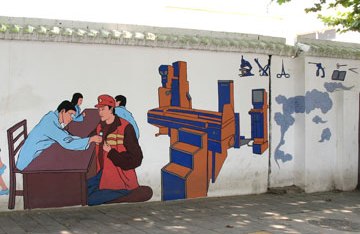
Occupational Disease
In recent years, China has
faced a critical situation in relation to occupational diseases (职业病),
and solving it will require the cooperation of the legislators, government
officials, enterprises and even workers themselves. For example:
Pneumoconiosis (尘肺)
is one of the most common occupational diseases; this is a chronic lung
disease caused by the inhalation of various forms of dust particles and
which leads to pulmonary fibrosis (肺纤维化).
National statistics shows that China has had over 50,000 cumulative cases
of Pneumoconiosis, with 8,000 to 9,000 new cases each year. In 2002,
China’s government passed The Law on the Prevention and Treatment of
Occupational Diseases. According to this law, laborers are entitled to
certain rights of occupational health protection (like having access to
relevant knowledge about occupational health), and employers must create a
work environment and conditions that meet the law’s occupational health
standards and health requirements. According to law, the government
hygiene department must keep on supervising the number of these cases. To
summarize, law makers, the government hygiene department, employers, and
workers have started to work together to fight Pneumoconiosis and China’s
other occupational diseases.
Group J09: Tues 3:15,
Rachel, Scarlet, Han Tingting, Liu Ruixiang, Angel, Cristina
This picture shows an expensive machine and a worker getting medical help.
This emphasizes the benefits common people get from China's public health
care system. In old China, neither common people nor the government had
enough money for comprehensive medical treatment. With the development of
society, the situation has changed: China's Health Ministry and the
Ministry of Finance are working together to improve the national health
infrastructure. The government has allocated 9.4 billion yuan to establish
the rural cooperative health system, and it looks like the State Council's
target of covering 80 percent of the country's rural areas by the end of
2007 will be met. In 2000, the country instituted a new cooperative system
to ease the burden of health costs on farmers, where one-third of the cost
would be borne each by the farmer, the local government, and the central
government. Furthermore, China is seeking to tighten regulations to
improve the quality of care and improve cooperation with other nations to
fight diseases that cross national boundaries. In the past, the poor
didn't have access to elementary medical treatment, but now, China's
public health care system allows both the poor and the rich to enjoy the
same medical treatment.
Team J07: Amanda, Jack, Jackie, Hermit
Click here for page two |
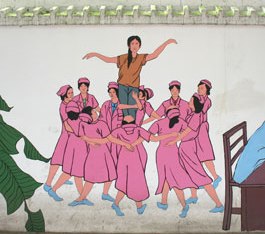
Nursing
The professionalism and personal
qualities of nurses and patient-nurse cooperation play an extremely
important role in restoring patients to complete health. First, nurses'
professionalism has a great impact on patients' physiological recovery.
During some medical procedures such as transfusions and surgical
operations, even a tiny mistake could put the patients at risk, but
skilled nurses make daily choices that bring healing. Second, nurses'
personal qualities impact patients' psychological recovery. When
interacting with patients, nurses should adopt a positive attitude, use
polite words and use good behavior. These personal qualities can help
change patients’ undesirable mindset and behavior, alleviate their anxiety
and nervousness, give play to their initiative and establish their
confidence to overcome the disease. In the end, the patients' restoration
to health depends on their understanding and cooperation with nurses.
Nurses’ professionalism, personal qualities, and harmonious relationship
with patients work together to bring the patients’ total physiological and
psychological recovery.
Group K09: Cathy, Liu Dan, Zhang Wei Wei,
Jason, Peter
Alternate conclusion:
Professionalism equips nurses to make critical choices, personal qualities
produce a good bedside manner, and cooperation from patients leads to a
harmonious relationship; together these aspects of nursing care work
together to bring the patients’ total physiological and psychological
recovery. (The real problem with the above paragraph was that the writers
tried to say too many unrelated things, so it was difficult to summarize
everything in the conclusion—without sounding too much like the Topic
Sentence.)
The
painting illustrates the core spirit of nursing: the patient is the center
of the nurse's concern. There are five basic things a nurse should do. (1)
Caring for the patient is the very heart of nursing. (2) Nurses work with
the doctors to cure the patients. (3) The nurse protects the patient's
privacy. (4) Nurses also teach the patient and family members to promote
health and prevent illness. (5) Nurses speak for patients (advocacy),
interceding when necessary. As a nurse, one should have love, patience,
circumspection and responsibility in order to give the patient hope and a
healthy life. Sometimes nurses should do more than just caring, such as
telling a story to the children or sacrificing their personal time to be
with the patient. Many changes have taken place since Florence Nightingale
(l820-1910) founded modern nursing. Today, the nurse plays a very
important role in the hospital. There is a saying that the doctor is the
angel, but we can also say that the nurse is the angel's wings. Due to the
wide scope of their work—caring, curing, protecting, teaching, advocating,
sacrificing and more—each of us should respect nurses and their career.
Team K07: Puredoctor, Robin, Judia, Julie, Wanjia |
|
This resource was created for and by our students under my
understanding of "fair use" for educational resources.
I apologize if the students plagiarized from other
sources without telling me!
As far as I am concerned, people are allowed to
print/copy it for personal or classroom use.
If you print/use this, please see Website
Standards and Use Policy for things posted at www.krigline.com and
www.krigline.com.cn.
|

Click in the boxes below to go to some of our most popular pages. If
you get lost, just click "Home."
See our
Policy
regarding the use of materials available at Krigline.com or
Krigline.com.cn |











